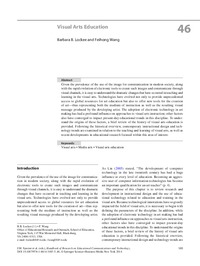Visual Arts EducationBarbara B. Lockee, Feihong Wang
Zu finden in: Handbook of Research on Educational Communications and Technology (Seite 583 bis 590), 2014
|
 |
 Diese Seite wurde seit 3 Jahren inhaltlich nicht mehr aktualisiert.
Unter Umständen ist sie nicht mehr aktuell.
Diese Seite wurde seit 3 Jahren inhaltlich nicht mehr aktualisiert.
Unter Umständen ist sie nicht mehr aktuell.
 Zusammenfassungen
Zusammenfassungen
 Given the prevalence of the use of the image for communication in modern society, along with the rapid evolution of electronic tools to create such images and communicate through visual channels, it is easy to understand the dramatic changes that have occurred in teaching and learning in the visual arts. Technologies have evolved not only to provide unprecedented access to global resources for art education but also to offer new tools for the creation of art—thus representing both the medium of instruction as well as the resulting visual message produced by the developing artist. The adoption of electronic technology in art making has had a profound influence on approaches to visual arts instruction; other factors also have converged to impact present-day educational trends in this discipline. To understand the origins of these factors, a brief review of the history of visual arts education is provided. Following the historical overview, contemporary instructional design and technology trends are examined in relation to the teaching and learning of visual arts, as well as recent developments in educational research focused within this area of interest.
Given the prevalence of the use of the image for communication in modern society, along with the rapid evolution of electronic tools to create such images and communicate through visual channels, it is easy to understand the dramatic changes that have occurred in teaching and learning in the visual arts. Technologies have evolved not only to provide unprecedented access to global resources for art education but also to offer new tools for the creation of art—thus representing both the medium of instruction as well as the resulting visual message produced by the developing artist. The adoption of electronic technology in art making has had a profound influence on approaches to visual arts instruction; other factors also have converged to impact present-day educational trends in this discipline. To understand the origins of these factors, a brief review of the history of visual arts education is provided. Following the historical overview, contemporary instructional design and technology trends are examined in relation to the teaching and learning of visual arts, as well as recent developments in educational research focused within this area of interest. Dieses Kapitel erwähnt ...
Dieses Kapitel erwähnt ...
 Begriffe KB IB clear | Zone of Proximal Development |
 Anderswo finden
Anderswo finden
 Volltext dieses Dokuments
Volltext dieses Dokuments
 |  Visual Arts Education: Artikel als Volltext bei Springerlink ( Visual Arts Education: Artikel als Volltext bei Springerlink ( : :  , 449 kByte; , 449 kByte;  : :  2020-11-28) 2020-11-28) |
 Anderswo suchen
Anderswo suchen 
 Beat und dieses Kapitel
Beat und dieses Kapitel
Beat hat Dieses Kapitel während seiner Zeit am Institut für Medien und Schule (IMS) ins Biblionetz aufgenommen. Beat besitzt kein physisches, aber ein digitales Exemplar. Eine digitale Version ist auf dem Internet verfügbar (s.o.). Aufgrund der wenigen Einträge im Biblionetz scheint er es nicht wirklich gelesen zu haben. Es gibt bisher auch nur wenige Objekte im Biblionetz, die dieses Werk zitieren.










 Biblionetz-History
Biblionetz-History